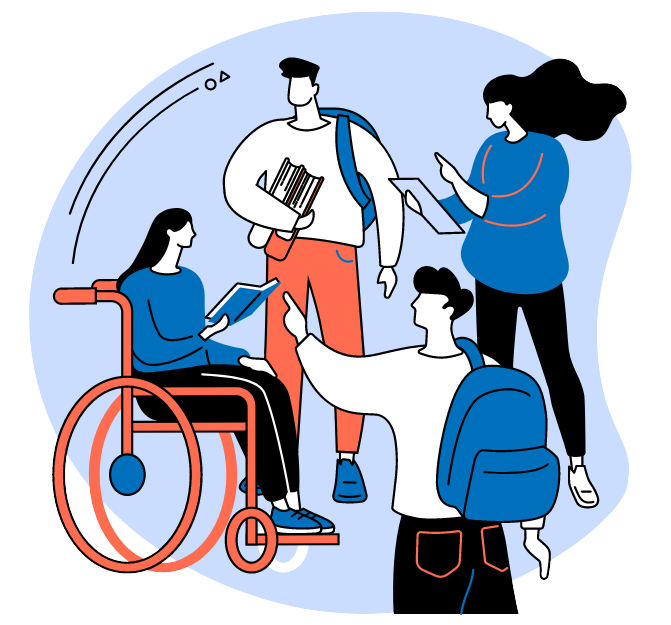How can we advance access and equity in higher education? What are the challenges and opportunities that we face in this? How can we leverage technology, innovation, and collaboration to create more inclusive and diverse learning environments? These are some of the questions that this blog will explore and address.
Not every student has the same opportunity to access and benefit from higher education. Many factors can create barriers and inequalities for students and impact their likelihood of success. As a result, advancing access and equity for these students in higher education is critical.
Types of Disadvantaged Students in Education
Underrepresented or disadvantaged students are those who face barriers or challenges in accessing and succeeding in education due to factors such as race, ethnicity, gender, disability, socioeconomic status, language, or geographic location.
Some examples of underrepresented students are:
- Students of color, who may experience discrimination, stereotyping, lack of culturally inclusive environments and additional socioeconomic barriers to success.
- Female students in STEM fields, who may encounter gender bias, harassment, a lack of female role models and professional development opportunities.
- Students with disabilities, who may have difficulty finding adequate accommodations, support services, or inclusive learning environments.
- Low-income students, who may struggle with financial constraints, food insecurity, or limited access to technology and other resources.
- First generation students, who may struggle in their preparedness for university, lack a feeling of belonging and adequate support systems.
- English language learners, who may face language barriers, academic gaps, or low levels of parental involvement.
- Rural students, who may have limited exposure to diverse perspectives, opportunities, or accommodation and transport.

Challenges in Advancing Access and Equity
Advancing access and equity is an important goal for higher education, but it also poses significant challenges. Some of the challenges in advancing access and equity in higher education include:
– The persistent gaps in academic achievement and attainment among underrepresented student groups.
– The lack of adequate financial support and resources for students who face barriers to access and success, such as tuition fees, living expenses, transportation, childcare, or health care.
– The need for more diverse and inclusive curricula, pedagogy, faculty, staff, and leadership that reflect and respect the diversity of students and society.
– The impact of social and cultural factors on students’ sense of belonging, engagement, and identity in higher education, such as stereotypes, discrimination, microaggressions, or campus climate.
Strategies to Support Disadvantaged Students
To support disadvantaged students in accessing and succeeding in higher education, institutions need well-defined policies, streamlined strategies, effective incentives and appropriate support services and resource allocation.
Some of the most effective strategies to advance access and equity in higher education include:
1. Recruitment, Enrolment and Opportunity
Work to support disadvantaged students should begin before they set foot on your campus or enrol at your institution. The initial work should begin in creating courses and modules that will suit and appeal to underrepresented groups, to attract them to higher education. Secondly, institutions should be actively recruiting students from underrepresented groups, creating pathways between local high schools or community colleges.
In addition, educators should enhance the readiness of potential students through academic preparation such as bridging programs and work to remove financial and access barriers through lower tuition fees for underrepresented groups, greater scholarship opportunities and affordable accommodation options.
2. Comprehensive Student Support Systems
As well as financial support and academic preparedness, higher education institutions need robust student support systems to provide a wide range of assistance for the diverse challenges these students face. Disadvantaged students often have a greater need for mental health services, financial aid and budgetary advice, career guidance and academic advising, than other student groups.
It is important to give students access to these resources as early as possible in their education journey and ensure they are aware of the support available to them. In addition, it is crucial education institutions make their support services as effective as possible for the students who need them most.
In many cases, disadvantaged students have lower satisfaction and effectiveness rates for student services than their more advantaged peers. As a result, institutions need to do more to improve this.
Campus career centres can help level the playing field for women in STEM education and academic advising or mentoring can significantly improve student success for students of colour.
3. Digital Technologies to Support Student Success
Digital technology is another key tool in advancing access and equity in education. Data analytics can help institutions evaluate their policies and strategies, understand student’s needs, provide more personalised, effective support and improve interventions for disadvantaged students.
Successful data analytics systems are often supported by an early warning system that will prompt interventions and timely outreach from staff. These systems can also greatly contribute to the success of academic advising efforts and other support services. With more insights into student progression, advisors can provide more effective, targeted support. In addition, having student data centrally stored in one system across different support services, can eliminate the ineffectiveness, inefficiency and time delay often associated with data silos.
Advancing access and equity is a critical goal for higher and further education. To be successful in this, institutions need to be proactive in supporting the recruitment, persistence, graduation and life-long success of underrepresented and disadvantaged students. Equity today implies much more than equal opportunity; it entails equality of resources, ideas, respect and outcomes.
CONTACT US
Learn more about how SEAtS can help you achieve your access and equity goals today.









